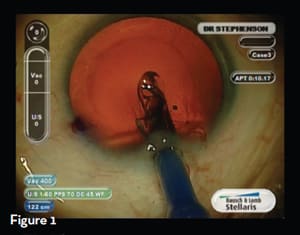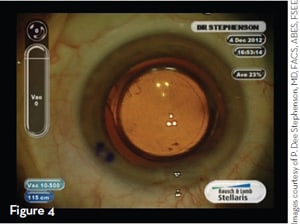Tracking Outcomes with the enVista IOL
Features that include aberration-free optics, a PCO-minimizing design and a lack of glistenings make this lens an excellent choice.
BY P. DEE STEPHENSON, MD, FACS, ABES, FSEE
As a refractive cataract surgeon, I'm focused on meticulously tracking my outcomes. It's the only way to ensure that I'm performing the most effective procedure possible. I use a results data bank to analyze and refine the performance of the technologies and techniques I adopt, so each step of surgery is reproducible. This also allows me to inform patients about what to expect with complete confidence. Naturally, when I was among the first surgeons in the country to utilize the enVista IOL (Bausch + Lomb), I followed this same approach.
The enVista IOL is a single-piece hydrophobic acrylic lens, the most widely implanted IOL material in the United States, but the enVista is designed to resist the formation of glistenings, the fluid-filled microvacuoles that have been known to compromise the optical clarity of other IOLs. Its FDA-approved label states "No glistenings of any grade were reported for any subject at any visit in the clinical study." To prevent glistenings, the enVista IOL is pre-hydrated to equilibrium water content so it will neither gain nor lose water. It is then packaged in physiologic (0.9%) saline solution, the same salt concentration as the eye, to eliminate fluid exchange with the aqueous humor. As a result, when the IOL is placed in the eye, nothing changes and water-filled vacuoles do not form.

Figure 1. Implantation of the enVista IOL through a 2.2-mm incision.

Figures 2-4. Once inserted, the enVista lens unfolds in a controlled manner, allowing time for complete removal of viscoelastic.
My analysis of my first 50 enVista IOL cases, in which I also used the ORA System (WaveTec Vision) for intra-operative wavefront aberrometry, demonstrated excellent results. I followed my usual protocol for pre-operative measurements, including K readings, the IOLMaster (Carl Zeiss Meditec) and OCT of the macula, and used my usual formulas for calculating IOL power. (None of the eyes had concomitant pathologies.) Once a cataract was removed, I took an aphakic ORA reading to see whether it confirmed my pre-op IOL power calculation or suggested a different power. If ORA indicated a different power would produce better vision results, I chose that power, which I did in approximately 54% of the cases. Post-operatively, 99% of the eyes had uncorrected distance visual acuity of 20/40 or better, and 100% of the eyes had bestcorrected visual acuity of 20/20 or better. In addition, giving a clear indication of the value of the intraoperative aberrometry, 100% of eyes were within a half diopter of the target refraction and 72% were within a quarter diopter. The mean absolute prediction error for the first 50 cases was 0.17, and the standard deviation was 0.11. Overall, I have implanted approximately 150 enVista lenses and have consistently achieved these LASIK-like results.
Why the enVista IOL?
The absence of glistenings was a powerful incentive for adding the enVista IOL to the group of lenses I prefer to implant. Most of the hydrophobic acrylic IOLs I'd previously used often developed at least some level of glistenings. Typically they would appear early, in 6 to 8 weeks after surgery, and progressively become more apparent. In one study, the glistenings observed continued to increase for up to 10 years.1 I don't see glistenings as something to be dismissed as a non-issue. In my experience, they have a propensity to adversely affect vision. Furthermore, a situation best avoided is one in which a patient has good post-op Snellen acuity but vision complaints that can be attributed only to a problem with the lens I implanted.
A lack of glistenings isn't the only reason the enVista has become my monofocal lens of choice. Its other attributes are crucial for flawless outcomes as well. With two aspheric surfaces that neither add nor subtract spherical aberration to the eye, the lens maximizes the number of patients who can benefit from the proven higher quality of vision an aspheric design provides. In addition, because the lens is truly aspheric, its power is uniform from center to edge and its performance is unaffected in the event of pupil decentration, optical misalignment, or IOL decentration or tilt. None of my enVista patients have complained about glare, halos, dysphotopsia or problems with driving at night.
In addition to its unique optic design, the enVista IOL incorporates design elements that are believed to minimize posterior capsular opacification (PCO). It has a 360° square barrier edge to inhibit migration of lens epithelial cells, and the haptics vault the optic posteriorly for direct contact with the capsular bag. My PCO rate with the enVista has been very low. I've performed only three YAG laser procedures after nearly 150 implantations.


Prior to the availability of the enVista IOL, the majority of my monofocal lens patients received either the fourth-generation silicone SofPort AO (Bausch + Lomb), unless they had known retina problems that could require surgery with silicone oil in the future, or the Akreos MICS (Bausch + Lomb) because it can be implanted through an unenlarged 1.8-mm incision. I still consider both to be good options, and I still implant the SofPort AO in cases where there are issues with the integrity of the capsular bag because its three-piece design allows placement in the sulcus. I have also replaced many older hydrophobic acrylic IOLs that had developed problematic glistenings with either Akreos MICS or enVista lenses. However, when all else is equal, being able to avoid glistenings leads me to choose the enVista in most of my monofocal lens cases.
The enVista IOL in the Operating Room
The quality of the enVista IOL material is readily apparent when removed from its packaging. It looks much clearer than other acrylic lenses and has no marks or scratches. It is durable as well as flexible. Even though it can be folded small enough to be implanted through a 2.2-mm incision, (Figure 1), it isn't creased by forceps or a second instrument. I have found it to be far less susceptible than other lenses to scratches and tears.
Once inserted, the lens unfolds in a controlled manner (Figures 2-4). This is an advantage for me because I'm able to remove all of the viscoelastic as the lens is opening fully and reinflate the globe prior to taking my final aberrometry reading. In contrast to some of the other acrylic lenses I've tried, the enVista doesn't unfold too quickly or stick to itself.
It's About Time
The enVista IOL includes all of the time-tested features cataract surgeons have come to expect, with the added advantage of no glistenings. It enables a hassle-free procedure for me and contributes to excellent vision outcomes for my patients in the short and long term. No other hydrophobic acrylic lens on the market offers its combination of aberration-free optics, foldability with durability and the expectation that glistenings will not develop. I've been amazed at how beautifully the lens centers in the eye and how clear it looks. In my hands, I believe it's the best choice among monofocal IOLs, and I'm happy to be free of the risk of glistenings.●
Reference
1. Behndig A, Mönestam E. Quantification of glistenings in intraocular lenses using Scheimpflug photography. J Cataract Refract Surg. 2009;35(1):14-17.

|
Dr. Stephenson is the founder of Stephenson Eye Associates, which is based in Venice, Fla., and has been serving patients along the state's southwest coast since 1989. She specializes in microincisional refractive cataract surgery and premium intraocular lenses. She is also an associate professor at the University of South Florida. |








